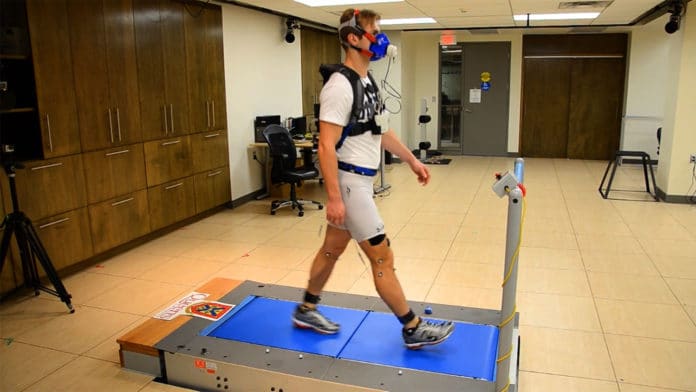Many devices have been developed to harvest energy from walking or running, but their use often comes at a cost to the wearer in the form of increased metabolic demand.
Now researchers in Canada have developed a lightweight exoskeleton that can harvest mechanical energy from a natural walking gait and convert it to useable electrical energy while also reducing the metabolic energy consumption of the user. The device can also make walking more efficient by taking the strain off leg muscles.
This new device assists users by removing energy which helps the knee muscles during a critical moment – called the terminal swing phase. The exoskeleton weighs 1.3 kilograms and fits into a small backpack – enabling hikers to walk longer distances or helping nurses be less tired after a long shift on their feet.
Two cables extend down from the backpack that are attached to the legs above the ankle and strapped around the legs. The design resists the forward swing of the leg during a stride.
In addition to assisting the user, the device converts the wearer’s kinetic energy as they walk into electricity that can be used to power the device’s control system and other portable devices. This energy harvesting capability could be particularly useful for individuals traveling on foot in remote locations, allowing them to charge cellular phones or GPS devices.
The researchers tested the exoskeleton on ten volunteers who walked on and off a treadmill. They found that the device reduced the metabolic effort required to walk by 3.3% while also converting the removed energy into roughly 0.25 watts per gait cycle.
“For the first time, we have demonstrated that removing energy can increase walking efficiency,” says Michael Shepertycky, a recent Ph.D. graduate. “This is a significant advancement in the field of exoskeleton development, and one with the potential to change the way that we approach gait assistance. The publication of this work in one of the most prestigious scientific journals highlights the research expertise and excellent facilities at Queen’s, as well as the world-class multidisciplinary education that I received here.“
The team hopes that the device should have numerous practical applications – like helping take the strain off nurses, waiters, postal workers, teachers, and others who spend long days on their feet.
